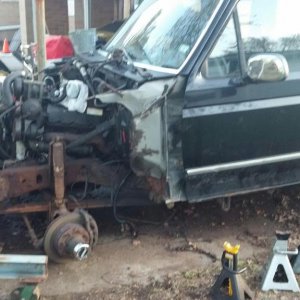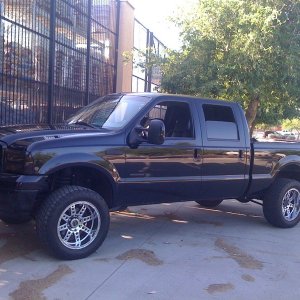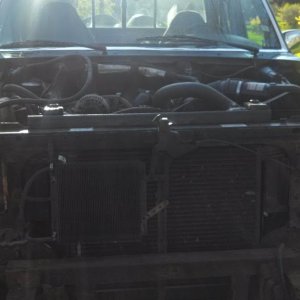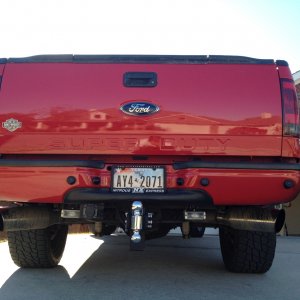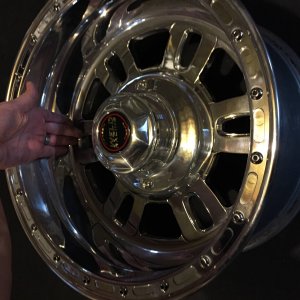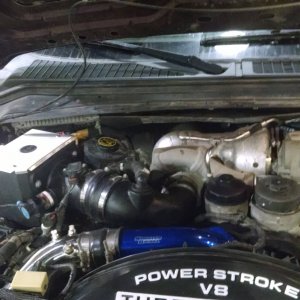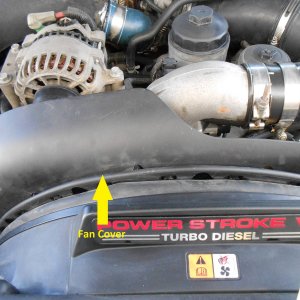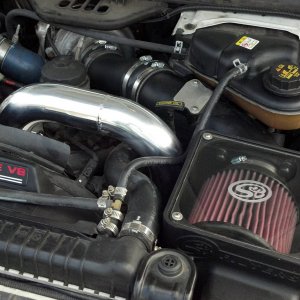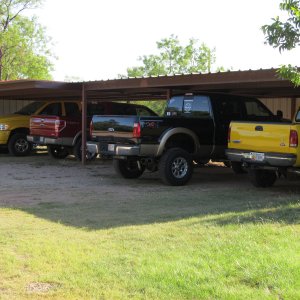Power Hungry
Member
Okay… So you've spent a small fortune to get your 6.0L Powerstroke Diesel to a point where it's a reliable workhorse. You've done the Head Gaskets, Head Studs, EGR delete kit (or at the very least a Bulletproof EGR Cooler), new Oil Cooler, Coolant Filter, and you're topped off with ELC. Reliability? Check!
Next, you take a quick poke around the forums and you find information on installing the "blue" regulator spring in the filter housing, adding the modified banjo bolts where the fuel lines attach to the heads, and you might even upgrade your fuel pump. Fuel delivery? Check!
Of course, no 6.0L is complete without some sort of programmer, so you plunk your money down and go with your brand of choice on a tuner to "turn up the heat", so to speak. At this point, you're probably making somewhere in the 420 to 450 RWHP range. The Mustangs and Ricers in your area are quickly becoming afraid to go up against your truck at the red light (not that we condone such actions…) and you're still able to pull a boat or camper on the weekend. Yep, life is good. Or so you think!
Now wait a minute! I just got finished saying that we've got everything covered from a reliability standpoint, didn't I? Unfortunately, there is something that everyone seems to overlook on the 6.0L… The High Pressure Oil System. I'll be the first to admit that I never really gave this much thought either.
On the 7.3L Powerstroke Diesel, modified High Pressure Oil Pumps (HPOPs) are about as common as the 7.3L itself. Nearly every truck with modified injectors (and many with stock injectors) has realized benefits to running a modified HPOP. It's just par for the course. However, on the 6.0L Powerstroke, High Pressure Oil Delivery is almost completely overlooked. Maybe this is because of the scarcity of offerings for the 6.0L or maybe it's just because the 6.0L crowd just isn't aware of the shortcomings of the factory High Pressure Oil System. Well, that is all about to change.
Being a staunch 7.3L guy and having tuned the ubiquitous Powerstroke for over 15 years, there isn't much we haven't seen. Since the High Pressure Oil System is what actually does the work to get the fuel into the engine, it's just standard procedure to install a big HPOP or a dual HPOP setup when you install larger injectors on these engines. Anyone that has been around the 7.3L for more than 30 seconds will tell you that oil pressure is absolutely key to the function of the injection system, affecting proper atomization and fuel delivery as well as the efficiency of these engines. What is interesting is that the 6.0L enthusiasts tend to completely overlook this area in their quest for performance and HP.
Our daily driver/test truck is a 2004, 2WD Standard Cab Long Bed. As it sits, we've already had the heads done, EGR delete, and had tuned the truck to a solid 430 HP which then ran a respectable 14.129 @ 97.6 MPH on street tires and an open differential. The addition of slicks, a limited slip differential, and a Snow Performance water-meth kit kicked the HP up to 480 HP and netted a 12.961 @102.62. Yeah, that's moving for an otherwise bone-stock truck. Like everyone else, I thought everything was going pretty well. Little did I know just what I was missing.
I had happened to spend some time talking on the phone with Bob and Sheryl at DieselSite about our little 6.0L, including future plans for the truck and the point we were already at. Suddenly Bob had brought up an interesting question. "What are your ICP (Injection Control Pressure) and IPR (Injection Pressure Regulator) numbers?" Feeling pretty confident with my tuning, I assured Bob that our ICP numbers were pretty stable, to which he replied, "No they're not. If you're checking the pressure at the ICP sensor in the head, it's wrong." He then went into a detailed description of the shortcomings of the factory oil delivery system and how there is a significant pressure drop between the HPOP manifold and the ICP sensor at the end of the oil rail on the passenger side head. Well, that got my gears spinning and I decided I was going to find out for myself just exactly what was going on with the factory system.
NOTE: I want to clarify that MOST tuners of the 6.0L will deliberately modify the ICP transfer curves in order to trick the ECM into raising the injection pulsewidth. If you connect a scantool or other type of monitoring device to the OBD-II port and watch the PID for ICP *PRESSURE*, you are nearly always going to see that the numbers are unusually low. In most cases, the ICP values will be about half of what the actually pressure is. When monitoring ICP, ALWAYS use the ICP *VOLTAGE*, NOT the ICP Pressure output. These values are the actual voltage output of the sensor before the ECM converts the voltage value to a pressure.
For initial testing purposes, I used an Edge Evolution and installed the EAS Analog Input kit. A second ICP sensor was installed in the manifold of the HPOP so that I could take reading directly from both the HPOP and ICP sensor in the head. I set the Evolution to monitor VOLTAGE of both the factory ICP sensor and the secondary ICP sensor, strapped the truck down on the dyno, and began my testing. What I found shocked me more than I could have anticipated.
Under normal driving conditions, the pressure drop between the pump and the head was negligible. There was some difference, but not what I would consider to be anything significant. However, under a full throttle run things changed dramatically. As my fuel demand increased, I started seeing a noticeable deviation between the HPOP and the head. The full realization came when I finally did a full throttle run. The difference was staggering! As they say, a picture is worth a thousand words and the following datalog image is no exception…
[Click on image to enlarge]

As you can clearly see, there was a tremendous shift in pressure between the HPOP and the oil rail in the head, to the point where it flatlined the secondary sensor output. The initial pressure drop spiked at just over 750 PSI (and that's just what we could measure, since the pump-mounted sensor went out of range!!!), coinciding with the peak Mass Fuel Desired (MOD) request of 74 ms/Stroke. As the RPMs continued to climb and the MFD tapered off, the pressure difference began to close. In analyzing this data, we can clearly see that the oil consumption of the injectors exceeds the flow characteristics of the factory oil delivery system. What's even more concerning is that because of the drop in pressure, the HPOP is being forced to work harder than necessary to build pressure. This additional pressure causes oil temperatures to quickly rise and on hard runs we'd actually see about a 10ºF rise in the 10 seconds it took to perform the run. For calculation purposes, each volt on the ICP sensor equals 967 PSI of oil pressure. With that in mind, the pressure we were demanding from the pump at about 4.3 volts was 3915 PSI. (There is a 0.25 volt offset at the low end of the sensor, so the actual voltage/pressure calculation was 4.05 volts.) Even with the HPOP mounted sensor maxed out at 5.006 volts, the pump was trying to produce right at 4600 PSI ((5.006 - 0.25) * 967). This number could have even been higher! Not good at all, for sure.
So where does that leave us?
After completing my test runs, I again talked to Bob at DieselSite and relayed my findings. Of course, he wasn't terribly surprised at my numbers. He explained to me the testing he'd done with another tuner and how they'd experienced similar results. The feedback from that initial testing led Bob to develop the High Pressure Oil Delivery System (HPODS). He suggested that we install the kit and then retest everything just so we'd have some solid before and after results. We ordered the kit and had it arrive a few days later. Unfortunately, some preparations were necessary to install the kit so it took a while before we were actually able to get the kit installed.
The kit itself is pretty self explanatory. A high pressure hose feeds from the HPOP manifold to a distribution block, which then splits the oil feed to the two heads. The ICP sensor is removed from the passenger side head and relocated to the distribution block. A hose then goes from the distribution block to the ICP sensor port on the passenger side head. That's the easy part of the installation. The difficult part comes when installing the driver's side hose. Since the driver's side Valve Cover doesn't have a hole to access the ICP sensor port, a second passenger side valve cover will need to be purchased and installed. On the surface, this sounds pretty simple. However, keep in mind that the crankcase breather is part of the driver's side valve cover. Replacing the valve cover will eliminate the breather and if not addressed, you'll end up blowing out a gasket or seal due to excessive crankcase pressure. A simple solution is to drill and tap the factory oil fill tube and install a fitting in the side to allow for the venting of any crankcase gasses. Then simply run a "road draft" style tube to discharge the gasses below the vehicle. If you're really creative, you can even plumb the tube into your exhaust system so that the gasses discharged through the tailpipe. We did have to make a modification to the tube in order to prevent oil from splashing out the fitting. This was done by cross drilling the bottom end of the tube and inserting a rolled-up sheet of Scotch-Brite pad to act as a filter. This actually worked quite well, with the only difficulty being that we'll have to remove the oil fill tube to actually fill the engine after an oil change. Either that, or just pour the oil slowly. I'm looking into an alternative, but that's another project.
So with all that done, it's time to see how we made out. I had my initial suspicions about what to expect since, in theory, we have effectively doubled the oil feed to the heads. After a few cranks to purge the oil from the lines (HIGHLY recommend doing this via the ICP sensor port on the distribution block since it will be the highest point in the system) the truck fired right up. We took the truck for a spin to make sure all the bubbles were worked out and I'd have to say that just from a seat-of-the-pants perspective, the truck seemed to be a bit more responsive, although there's nothing that's really definitive. Also, as I'd come to a stop the truck seemed to idle a bit smoother and quieter. Again, nothing definitive… just my initial impressions. So, let's move on to something that is measurable.
Strapping the truck back on the dyno, we got everything set up to record. This was considerably trickier since basically every fitting orifice had a hose running to or from it. After a handful of fittings, bolts, a welder, and 1 day and a half of messing around, we finally had a setup that would provide pressure readings that were in the same location as the original tests. Running the same tuning as the original testing with the same load conditions, we immediately noticed that the pressure drop from the pump to the head was reduced to pretty much 0 PSI and the truck seemed to pull just a little better on the dyno. After a few more runs to make sure everything was going to hold together and not spray the engine with hot oil, we got into a couple power runs. The difference was clearly defined...
[Click on image to enlarge]

While still experiencing some minor fluctuations in pressure, this graph shows that over 96% of the pressure drop between the HPOP and the head was eliminated. With the original run peaking at (at least) 756 PSI pressure drop and the HPODS equipped run peaking at only 28 PSI, the system is certainly doing its job. I had honestly expected the final pressure drop to be a little lower (actually, close to zero), but oil is still a viscous fluid and there is going to be some resistance when pushing it, so some small variation is acceptable. Either way, it's still quite impressive. The evidence shows, without question that 1) the factory High Pressure Oil system has some serious flow limitations and 2) the HPODS helps to nearly completely eliminated the pressure drop by providing a second oil channel to the heads. Even the spikes observed in the oil system that were caused by the Mass Fuel Desired fluctuations during the first run were smoothed out. One other thing we noticed is that temperature rise during the runs dropped to about 6ºF. Not much, but an added bonus nonetheless. The pump is obviously not working nearly as hard now and it's a safe bet that it'll last longer.
Overall, this has been quite an interesting experience in understanding (or at least attempting to understand) the fluid dynamics between the HPOP and oil rails. The subsequent drivability improvements, faster starts, smoother idle, and reduced stress on the HPOP have alone made this setup worthwhile. When combined with larger injectors, this system would pretty much be a requirement. Since the initial testing, we've installed a set of modified injectors. We haven't had the time to go back and retest the HPODS pressures with these injectors, but with the truck currently producing 520 HP on fuel only, I'd say that the system is a winner!
For more information on the HPODS, contact Bob or Sheryl at DIESELSITE - DIESEL MAINTENANCE and PERFORMANCE.
Next, you take a quick poke around the forums and you find information on installing the "blue" regulator spring in the filter housing, adding the modified banjo bolts where the fuel lines attach to the heads, and you might even upgrade your fuel pump. Fuel delivery? Check!
Of course, no 6.0L is complete without some sort of programmer, so you plunk your money down and go with your brand of choice on a tuner to "turn up the heat", so to speak. At this point, you're probably making somewhere in the 420 to 450 RWHP range. The Mustangs and Ricers in your area are quickly becoming afraid to go up against your truck at the red light (not that we condone such actions…) and you're still able to pull a boat or camper on the weekend. Yep, life is good. Or so you think!
Now wait a minute! I just got finished saying that we've got everything covered from a reliability standpoint, didn't I? Unfortunately, there is something that everyone seems to overlook on the 6.0L… The High Pressure Oil System. I'll be the first to admit that I never really gave this much thought either.
On the 7.3L Powerstroke Diesel, modified High Pressure Oil Pumps (HPOPs) are about as common as the 7.3L itself. Nearly every truck with modified injectors (and many with stock injectors) has realized benefits to running a modified HPOP. It's just par for the course. However, on the 6.0L Powerstroke, High Pressure Oil Delivery is almost completely overlooked. Maybe this is because of the scarcity of offerings for the 6.0L or maybe it's just because the 6.0L crowd just isn't aware of the shortcomings of the factory High Pressure Oil System. Well, that is all about to change.
Being a staunch 7.3L guy and having tuned the ubiquitous Powerstroke for over 15 years, there isn't much we haven't seen. Since the High Pressure Oil System is what actually does the work to get the fuel into the engine, it's just standard procedure to install a big HPOP or a dual HPOP setup when you install larger injectors on these engines. Anyone that has been around the 7.3L for more than 30 seconds will tell you that oil pressure is absolutely key to the function of the injection system, affecting proper atomization and fuel delivery as well as the efficiency of these engines. What is interesting is that the 6.0L enthusiasts tend to completely overlook this area in their quest for performance and HP.
Our daily driver/test truck is a 2004, 2WD Standard Cab Long Bed. As it sits, we've already had the heads done, EGR delete, and had tuned the truck to a solid 430 HP which then ran a respectable 14.129 @ 97.6 MPH on street tires and an open differential. The addition of slicks, a limited slip differential, and a Snow Performance water-meth kit kicked the HP up to 480 HP and netted a 12.961 @102.62. Yeah, that's moving for an otherwise bone-stock truck. Like everyone else, I thought everything was going pretty well. Little did I know just what I was missing.
I had happened to spend some time talking on the phone with Bob and Sheryl at DieselSite about our little 6.0L, including future plans for the truck and the point we were already at. Suddenly Bob had brought up an interesting question. "What are your ICP (Injection Control Pressure) and IPR (Injection Pressure Regulator) numbers?" Feeling pretty confident with my tuning, I assured Bob that our ICP numbers were pretty stable, to which he replied, "No they're not. If you're checking the pressure at the ICP sensor in the head, it's wrong." He then went into a detailed description of the shortcomings of the factory oil delivery system and how there is a significant pressure drop between the HPOP manifold and the ICP sensor at the end of the oil rail on the passenger side head. Well, that got my gears spinning and I decided I was going to find out for myself just exactly what was going on with the factory system.
NOTE: I want to clarify that MOST tuners of the 6.0L will deliberately modify the ICP transfer curves in order to trick the ECM into raising the injection pulsewidth. If you connect a scantool or other type of monitoring device to the OBD-II port and watch the PID for ICP *PRESSURE*, you are nearly always going to see that the numbers are unusually low. In most cases, the ICP values will be about half of what the actually pressure is. When monitoring ICP, ALWAYS use the ICP *VOLTAGE*, NOT the ICP Pressure output. These values are the actual voltage output of the sensor before the ECM converts the voltage value to a pressure.
For initial testing purposes, I used an Edge Evolution and installed the EAS Analog Input kit. A second ICP sensor was installed in the manifold of the HPOP so that I could take reading directly from both the HPOP and ICP sensor in the head. I set the Evolution to monitor VOLTAGE of both the factory ICP sensor and the secondary ICP sensor, strapped the truck down on the dyno, and began my testing. What I found shocked me more than I could have anticipated.
Under normal driving conditions, the pressure drop between the pump and the head was negligible. There was some difference, but not what I would consider to be anything significant. However, under a full throttle run things changed dramatically. As my fuel demand increased, I started seeing a noticeable deviation between the HPOP and the head. The full realization came when I finally did a full throttle run. The difference was staggering! As they say, a picture is worth a thousand words and the following datalog image is no exception…
[Click on image to enlarge]
As you can clearly see, there was a tremendous shift in pressure between the HPOP and the oil rail in the head, to the point where it flatlined the secondary sensor output. The initial pressure drop spiked at just over 750 PSI (and that's just what we could measure, since the pump-mounted sensor went out of range!!!), coinciding with the peak Mass Fuel Desired (MOD) request of 74 ms/Stroke. As the RPMs continued to climb and the MFD tapered off, the pressure difference began to close. In analyzing this data, we can clearly see that the oil consumption of the injectors exceeds the flow characteristics of the factory oil delivery system. What's even more concerning is that because of the drop in pressure, the HPOP is being forced to work harder than necessary to build pressure. This additional pressure causes oil temperatures to quickly rise and on hard runs we'd actually see about a 10ºF rise in the 10 seconds it took to perform the run. For calculation purposes, each volt on the ICP sensor equals 967 PSI of oil pressure. With that in mind, the pressure we were demanding from the pump at about 4.3 volts was 3915 PSI. (There is a 0.25 volt offset at the low end of the sensor, so the actual voltage/pressure calculation was 4.05 volts.) Even with the HPOP mounted sensor maxed out at 5.006 volts, the pump was trying to produce right at 4600 PSI ((5.006 - 0.25) * 967). This number could have even been higher! Not good at all, for sure.
So where does that leave us?
After completing my test runs, I again talked to Bob at DieselSite and relayed my findings. Of course, he wasn't terribly surprised at my numbers. He explained to me the testing he'd done with another tuner and how they'd experienced similar results. The feedback from that initial testing led Bob to develop the High Pressure Oil Delivery System (HPODS). He suggested that we install the kit and then retest everything just so we'd have some solid before and after results. We ordered the kit and had it arrive a few days later. Unfortunately, some preparations were necessary to install the kit so it took a while before we were actually able to get the kit installed.
The kit itself is pretty self explanatory. A high pressure hose feeds from the HPOP manifold to a distribution block, which then splits the oil feed to the two heads. The ICP sensor is removed from the passenger side head and relocated to the distribution block. A hose then goes from the distribution block to the ICP sensor port on the passenger side head. That's the easy part of the installation. The difficult part comes when installing the driver's side hose. Since the driver's side Valve Cover doesn't have a hole to access the ICP sensor port, a second passenger side valve cover will need to be purchased and installed. On the surface, this sounds pretty simple. However, keep in mind that the crankcase breather is part of the driver's side valve cover. Replacing the valve cover will eliminate the breather and if not addressed, you'll end up blowing out a gasket or seal due to excessive crankcase pressure. A simple solution is to drill and tap the factory oil fill tube and install a fitting in the side to allow for the venting of any crankcase gasses. Then simply run a "road draft" style tube to discharge the gasses below the vehicle. If you're really creative, you can even plumb the tube into your exhaust system so that the gasses discharged through the tailpipe. We did have to make a modification to the tube in order to prevent oil from splashing out the fitting. This was done by cross drilling the bottom end of the tube and inserting a rolled-up sheet of Scotch-Brite pad to act as a filter. This actually worked quite well, with the only difficulty being that we'll have to remove the oil fill tube to actually fill the engine after an oil change. Either that, or just pour the oil slowly. I'm looking into an alternative, but that's another project.
So with all that done, it's time to see how we made out. I had my initial suspicions about what to expect since, in theory, we have effectively doubled the oil feed to the heads. After a few cranks to purge the oil from the lines (HIGHLY recommend doing this via the ICP sensor port on the distribution block since it will be the highest point in the system) the truck fired right up. We took the truck for a spin to make sure all the bubbles were worked out and I'd have to say that just from a seat-of-the-pants perspective, the truck seemed to be a bit more responsive, although there's nothing that's really definitive. Also, as I'd come to a stop the truck seemed to idle a bit smoother and quieter. Again, nothing definitive… just my initial impressions. So, let's move on to something that is measurable.
Strapping the truck back on the dyno, we got everything set up to record. This was considerably trickier since basically every fitting orifice had a hose running to or from it. After a handful of fittings, bolts, a welder, and 1 day and a half of messing around, we finally had a setup that would provide pressure readings that were in the same location as the original tests. Running the same tuning as the original testing with the same load conditions, we immediately noticed that the pressure drop from the pump to the head was reduced to pretty much 0 PSI and the truck seemed to pull just a little better on the dyno. After a few more runs to make sure everything was going to hold together and not spray the engine with hot oil, we got into a couple power runs. The difference was clearly defined...
[Click on image to enlarge]
While still experiencing some minor fluctuations in pressure, this graph shows that over 96% of the pressure drop between the HPOP and the head was eliminated. With the original run peaking at (at least) 756 PSI pressure drop and the HPODS equipped run peaking at only 28 PSI, the system is certainly doing its job. I had honestly expected the final pressure drop to be a little lower (actually, close to zero), but oil is still a viscous fluid and there is going to be some resistance when pushing it, so some small variation is acceptable. Either way, it's still quite impressive. The evidence shows, without question that 1) the factory High Pressure Oil system has some serious flow limitations and 2) the HPODS helps to nearly completely eliminated the pressure drop by providing a second oil channel to the heads. Even the spikes observed in the oil system that were caused by the Mass Fuel Desired fluctuations during the first run were smoothed out. One other thing we noticed is that temperature rise during the runs dropped to about 6ºF. Not much, but an added bonus nonetheless. The pump is obviously not working nearly as hard now and it's a safe bet that it'll last longer.
Overall, this has been quite an interesting experience in understanding (or at least attempting to understand) the fluid dynamics between the HPOP and oil rails. The subsequent drivability improvements, faster starts, smoother idle, and reduced stress on the HPOP have alone made this setup worthwhile. When combined with larger injectors, this system would pretty much be a requirement. Since the initial testing, we've installed a set of modified injectors. We haven't had the time to go back and retest the HPODS pressures with these injectors, but with the truck currently producing 520 HP on fuel only, I'd say that the system is a winner!
For more information on the HPODS, contact Bob or Sheryl at DIESELSITE - DIESEL MAINTENANCE and PERFORMANCE.

